The world of birds is filled with remarkable creatures, but few capture the imagination quite like the peacock. Renowned for its extravagant plumage, the peacock is more than just a beautiful spectacle. It is a fascinating subject for zoologists, an icon in human culture, and a vital part of its ecosystem. This article delves into the complete life of the peacock, exploring its origins, behavior, habitat, and its place in the world.
A Portrait of Majesty
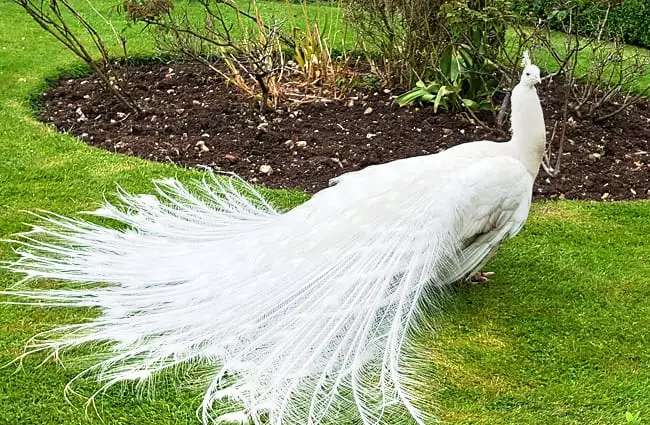
The term “peacock” often causes confusion. Technically, the male is the peacock, the female is the peahen, and the collective noun for both is peafowl. These large, colorful birds belong to the pheasant family, Phasianidae, and are native to India, Sri Lanka, and parts of Southeast Asia. There are three species of peafowl: the Indian Peafowl (Pavo cristatus), the Green Peafowl (Pavo muticus), and the Congo Peafowl (Afropavo congensis). The Indian Peafowl is the most commonly recognized, boasting iridescent blue and green feathers.
Physical Characteristics
Male Indian Peafowls are easily distinguished by their striking train, which isn’t actually the tail. It is an extension of the upper tail coverts that can reach over six feet in length. Each feather is adorned with an eye‑like pattern known as an ocellus. Peahens are less flamboyant, with mottled brown and green plumage that provides camouflage during nesting. Both sexes have strong legs and feet adapted for scratching in the soil for food.
Habitat and Distribution
Peafowl thrive in a variety of habitats, including moist deciduous forests, grasslands, and scrublands. They require access to water sources and prefer areas with trees for roosting. Originally native to the Indian subcontinent and Southeast Asia, these birds have been introduced to many parts of the world, including the Americas, Europe, and Australia. They have adapted well to these new environments and sometimes become naturalized populations.
Evolutionary History
The evolutionary origins of peafowl can be traced back millions of years. Fossil evidence suggests that their ancestors were similar to other pheasant‑like birds. The elaborate plumage of the peacock is believed to have evolved through sexual selection. Females preferentially choose males with the most impressive trains, leading to increasingly extravagant displays. This “runaway selection” process is a classic example of how natural selection can drive the evolution of seemingly impractical traits.
Diet and Foraging Behavior
Peafowl are omnivorous birds. Their diverse diet includes seeds, grains, fruits, insects, and small reptiles. They forage on the ground, scratching at the soil with their strong feet to uncover food. They also consume plants and berries. Their diet is seasonal, adapting to the availability of different food sources throughout the year.
Mating and Reproduction

The mating season for peafowl typically occurs in spring and early summer. Males engage in elaborate courtship displays to attract females. They fan their trains, vibrate their feathers, and emit loud calls. These displays are designed to showcase the male’s health and genetic quality.
Peahens carefully select their mates based on the size, color, and symmetry of their trains. Once a pair bond is formed, the peahen will lay a clutch of four to eight eggs in a shallow nest on the ground. The eggs are incubated by the peahen for about 28 days. The chicks, called peachicks, are precocial and relatively independent from birth. They can follow their mother and forage for food within a few days.
Ecological Role and Interactions
Peafowl play an important role in their ecosystems. They help disperse seeds, control insect populations, and serve as prey for larger predators. They interact with a variety of other animals, including monkeys, deer, and birds of prey. Their presence can also affect vegetation patterns, as they graze on plants and distribute seeds.
Peafowl and Humans
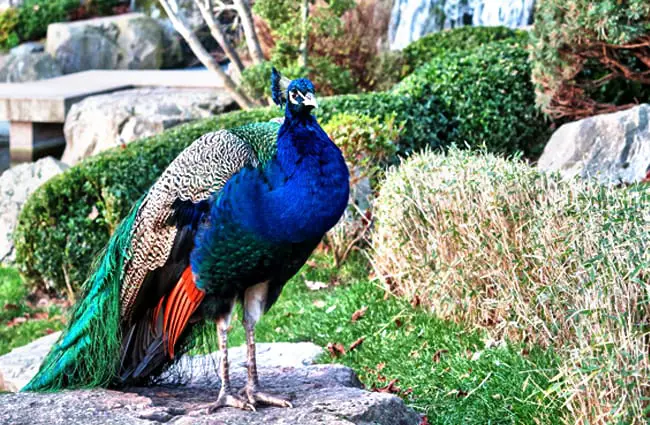
Peafowl have a long history of association with humans. They were domesticated in ancient India and have been kept as ornamental birds for thousands of years. In many cultures they are symbols of beauty, royalty, and good fortune. Their feathers are used in art, decoration, and traditional medicine.
However, introduced populations of peafowl can also pose challenges. They may compete with native species for resources, damage crops, and create noise pollution. In some areas they are considered pests and are subject to control measures.
Encountering Peafowl in the Wild
If you encounter peafowl in the wild, it is important to observe them from a distance. Avoid approaching them or attempting to feed them. Keep pets under control, as they may harass or injure the birds. Report any sightings of introduced populations to local wildlife authorities.
Caring for Peafowl in Captivity
Zookeepers and aviculturists caring for peafowl must provide spacious enclosures with plenty of vegetation and roosting perches. A varied diet of grains, fruits, and insects is essential. Regular health checks and vaccinations help prevent disease. It is also crucial to provide enrichment activities that stimulate natural behaviors.
Interesting Facts

- Peafowl can fly, although they typically prefer to walk or run. They use flight to escape predators or reach roosting sites.
- Their iridescent plumage is not due to pigment but to microscopic structures that refract light.
- Peafowl are known for their loud, distinctive calls, which can be heard over long distances.
- The Congo Peafowl is considered Vulnerable, threatened by habitat loss and hunting.
- Males often display their trains to rival males as well as females, establishing dominance hierarchies.
Conservation Status
The Indian Peafowl is listed as “Least Concern” by the International Union for Conservation of Nature (IUCN). The Green Peafowl is listed as “Endangered,” and the Congo Peafowl is considered Vulnerable. Habitat loss, hunting, and human disturbance are the primary threats to these species. Conservation efforts focus on protecting remaining habitats and promoting sustainable land management practices.
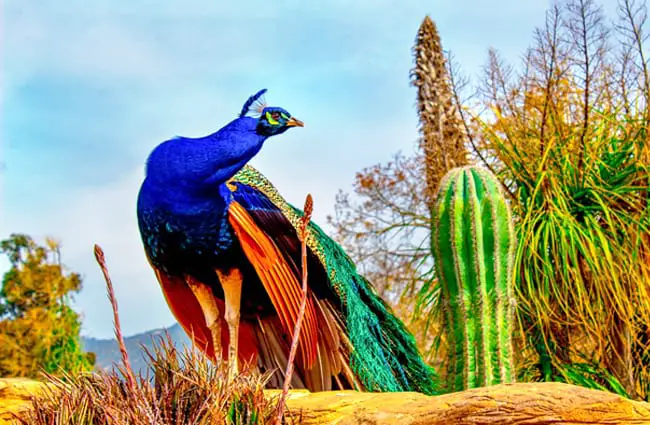
The peacock remains a captivating symbol of beauty and resilience. By understanding its biology, ecology, and cultural significance, we can better appreciate this remarkable bird and work toward ensuring its survival for generations to come.
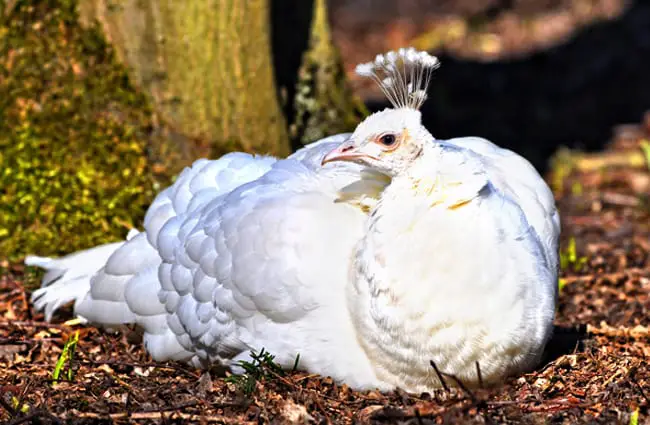
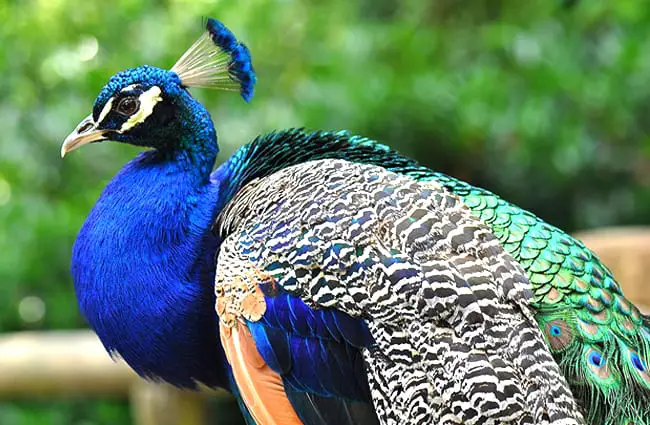

![Red Angus Closeup of a beautiful Red Angus cowPhoto by: U.S. Department of Agriculture [pubic domain]https://creativecommons.org/licenses/by/2.0/](https://animals.net/wp-content/uploads/2020/03/Red-Angus-4-238x178.jpg)




![Red Angus Closeup of a beautiful Red Angus cowPhoto by: U.S. Department of Agriculture [pubic domain]https://creativecommons.org/licenses/by/2.0/](https://animals.net/wp-content/uploads/2020/03/Red-Angus-4-100x75.jpg)

